More Problems
Problem 1:
(a) The capacitor in the circuit in the figure is made from two flat square
metal plates of length L on a side and separated by a distance d. What is the
capacitance?
(b) Show that if any electrical energy is stored in C, it is entirely
dissipated in R, after the switch is closed.
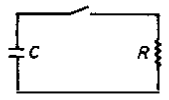
Solution:
- Concepts:
Capacitance, transient RC circuits - Reasoning:
As long as R ≠ 0 we ignore the self-inductance of the circuit and we ignore radiation. - Details of the calculation:
(a) For a parallel plate capacitor C = ε0A/d = ε0L2/d.
(b) Let q be the charge on the upper capacitor plate, I the current flowing clockwise after the switch is closed.
Kirchhoff's loop rule: q/C - IR = 0. I = -dq/dt.
dq/dt + q/(RC) = 0, q = Q0e-t/(RC). I = (Q0/(RC))e-t/(RC).
Energy stored in circuit before the switch is closed: U = ½Q02/C.
Rate at which the resistor is dissipating electrical energy : P = I2R = (Q02/(RC2))e-2t/(RC).
Total energy dissipated in R: ΔE = ∫0∞Pdt = (Q20/(RC2) ∫0∞ e-2t/(RC) dt = ½Q02/C = U.
The electrical energy is stored in C is entirely dissipated in R, after the switch is closed.
Problem 2:
For the AC circuit shown below, find the voltage VC2 across
capacitor C2 as a function of time.
Let V0 = 5 V, ω = 6.667*104/s, R1 = 3 kΩ,
R2 = 1 kΩ, C1 = 3*10-8 F, and C2 =
1.5*10-8 F.
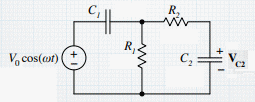
Solution:
- Concepts:
AC circuits - Reasoning:
We have a two-terminal network and an AC generator, generating a sinusoidal voltage. - Details of the calculation:
Only voltage difference matter. Choose the node at the bottom of the circuit to be at V = 0.
There are different approaches to setting up the solution.
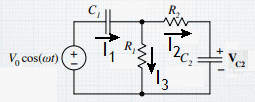
I1 = I2 + I3. (junction rule)
V - I1ZC1 - I3R1 = 0. (loop rule for left loop)
I3R1 - I2ZC2 - I2R2 = 0 (loop role for right loop)
We have 3 equations and 3 ubknowns.
VC2 = -I2ZC2.
Eliminate I1: V - I2ZC1 - I3ZC1 - I3R1 = 0.
I3 = I2(R2 + ZC2 )/R1.
Eliminate I3: V - I2ZC1 - I2(R2 + ZC2 )(ZC1 + R1)/R1 = 0.
VR1 - I2ZC1R1 - I2(R2 + ZC2 )(ZC1 + R1) = 0.
I2 = VR1/[ZC1R1 + (R2 + ZC2 )(ZC1 + R1)].
I2 = VR1/[-iR1/(ωC1) + (R2 - i/(ωC2))(-i/(ωC1) + R1)].
I2 = VR1/[-iR1/(ωC1) - iR2/(ωC1) + R2R1 - 1/(ω2C1C2) - iR1/(ωC2)].
I2 = VR1ωC2/[-iR1C2/C1 - iR2C2/C1 + R2R1ωC2 - 1/(ωC1) - iR1].
VC2 = -I2ZC2 = iI2/(ωC2) = V/[C2/C1 + (R2/R1)(C2/C1) + 1 + i(R2ωC2 - 1/(ωC1R1)].
Plug in numbers:
VC2 = (5 V)/[10/6 + i(0.833] = 2.68V exp(-iφ).
tanφ = 0.4999, φ = 0.464 = 26.56o.
VC2 = 2.68V exp(-i 26.56o).
DIFFERENT APPROACH:
I1 = I2 + I3. Rewrite in terms of voltages and impedances.
(V - VR1)/ZC1 = (VR1 - VC2)/ZR2 + VR1/ZR1,
(VR1 - VC2)/ZR2 = VC2/ZC2. (Two expressions for I3.)
Rearranging:
[1 + ZC1/ZR2 + ZC1/ZR1]VR1 - [ZC1/ZR2]VC2 = V.
VR1 = [1 + ZR2/ZC2]VC2.
Substitute:
[1 + ZC1/ZR2 + ZC1/ZR1][1 + ZR2/ZC2]VC2 - [ZC1/ZR2]VC2 = V.
Plug in the impedances. .
[1 + 1/(iωR2C1) + 1/(iωR1C1)][1 + iωR2C2]VC2 - VC2/(iωR2C1) = V.
Multiply the terms and group the real and imaginary parts.
V = VC2[[1 + C2/C1 + R2C2/(R1C1)] + i[ ωR2C2 - 1/(ωR1C1)]].
Plug in numbers.
(1.667 + 0.8333i)VC2 = 5 V, 1.863 exp(iφ) VC2 = 5 V
with tanφ = 0.4999, φ = 0.464 = 26.56o.
VC2 = 2.68V exp(-i 26.56o).
Problem 3:
A charged capacitor with C = 590 μF is connected in series to an inductor that has L = 0.330 H and negligible resistance. At an instant when the current in the inductor is I = 2.50 A, the current is increasing at a rate of dI/dt = 73.0 A/s. During the current oscillations, what is the maximum voltage across the capacitor?
Solution:
- Concepts:
LC tank circuit, quasi-static situation - Reasoning:
ω = (LC)-½ = 71.67/s, f = 11.4 Hz, radiation is negligible, energy stored in the circuit is conserved.
When any closed circuit loop is traversed, the algebraic sum of the changes in the potential must equal zero. - Details of the calculation:
Q/C + LdI/dt = 0. |Q|= LC|dI/dt|.
U = UC + UL = ½Q2/C + ½LI2= ½L2C |dI/dt|2+ ½LI2 = 1.202 J.
UCmax = 1.202 J = ½CVmax2. Vmax = 63.8 V.
or
Q = Q0cosωt, I = -ωQ0sinωt, dI/dt = -ω2Q0cosωt, ωI/(dI/dt) = 2.454 = tanωt.
Q0 = (dI/dt )/(ω2cosωt) = 3.767*10-2 C, Vmax = Q0/C = 63.8 V.
Note: ωt lies in the third quadrant, the tangent is positive the cosine is negative.
Problem 4:
(a) Find the Thevenin equivalent circuit for the two terminal
circuit shown.
(b) Find the Norton equivalent circuit for the two terminal
circuit shown.
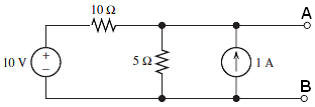
Remember:
- Any two terminal DC network can be replaced by a generator VTh in series with an resistance RTH.
- Any two terminal DC network can be replaced by a current source IN in parallel with an resistance RN = RTH.
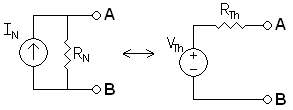
Solution:
- Concepts:
Equivalent circuits - Reasoning:
The Thevenin voltage VTH is an ideal voltage source equal to the open circuit voltage at the terminals. The Thevenin resistance RTH is the resistance measured at the terminals with all voltage sources replaced by short circuits and all current sources replaced by open circuits. - Details of the calculation:
(a) (i) Find the open circuit voltage.
Assume point B and the negative terminal of the voltage source are at ground.
Assume that point A is at voltage VA.
Use Kirchhoff's junction rule for the node above the 5 Ω resistor.
(10 V - VA)/(10 Ω) + 1 A = VA/(5 Ω). VA = 20/3 V.
(ii) Find RTH.
1/RTH = 1/(10 Ω) + 1/(5 Ω). RTH = (10/3) Ω.
(b) RN = RTH =(10/3) Ω.
IN is the current flowing through a short circuit. Since we already determined VTH and RTH, we have VTH - INRTH = 0.
IN = VTH/RTH = 2A.
We can also use Kirchhoff's loop rule to find IN.
Short out points A and B. Then no current will flow through the 5 Ω resistor.
The voltage at point A is zero.
IN = (10 V)/(10 Ω) + 1 A = 2 A.
(Any two of the tree quantities VTH, RTH = RN and IN determine the third.)